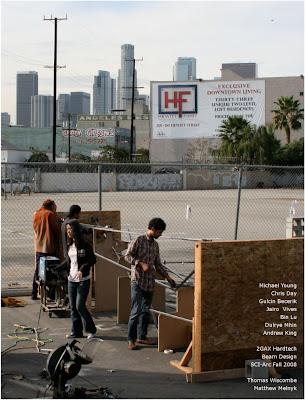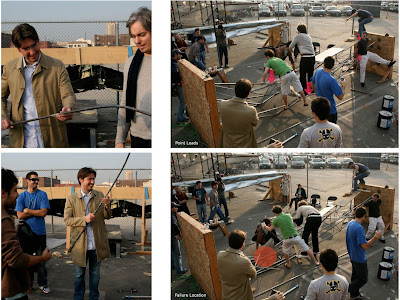


Infrastructural Architecture
Performative Morphologies for San Francisco Transit Hubs
2GBX Studio/SCI-Arc Spring 2009
Location: San Franciso, CA
Design Team: Bin Lu, Joongsik Yang
Time: 2009.1-4
Instructor: Tom Wiscombe, Peter Testa, Elena Manferdini
旧金山贝大桥汽车站
旧金山交通枢纽功能性形态学研究
原型-能源独立基础设施
Consistent with the Obama government's national transit and new technology initiatives, the main focus of our studio is finding the urban strategy considering infrastructure by scripting an parametric design with sustainable building technologies. We started with branching script and voronoi algorithm based on the main stream of the people coming to the bus station. We obtained our main design pattern implying people's flow from this main path. Based on the ALGAEtech works with direct sunlight, we applied them into our roof system and building façade so the result was the best synergy effect in both visual and technical terms. Harvesting algae for biofuels enhances transportation fuel production while mitigating CO2, clean the air around the bus station area.
为了贯彻美国奥巴马政府国家交通和新兴科技创新性,工作室主要专注于寻找城市决策,考虑基础设施用参数化的设计以及可持续建筑技术结合完成。我们开始于分支程序与voronoi 算法,基于来自汽车站的主要人流。我们得到主要设计图案预示了主要的人的流动路径。基于海藻科技需要直接的自然光照运行的原理,我们将他们运用在我们的屋顶系统以及建筑立面中,这样最终的结果是同时视觉上与技术上最好的协同效果。收获的海藻给生物燃料扩张了交通燃料产品,同时减轻二氧化碳,净化汽车站周围的环境。
Our site has a level difference about 24meters, so we tried to divide the terminal with the local bus bay area and greyhound terminal. The 1st floor is used for loading space for public from taxi and parking space for the bikes, 2nd floor is bay area for local buses and 3rd floor is for the greyhound bus. The local bus can enter into terminal from Beale Street and it can go through 2nd floor and exit through Harrison Street. Greyhound bus comes from highway and goes directly into the greyhound terminal at third floor and it exits out to the Beale Street through the connective ramp. For structural solution, we designed the star shape structure by dividing steel pipes and assembling the segments again inversely. And this way, the star structure allowed algae tubes to be combined and fixed well into the main structure.
我们的基地有24米的高差,所以我们尝试把汽车站分流成湾区市内公车以及灰狗长途汽车。一楼是供下客空间所用,包括车站内的汽车以及大众出租车,停车空间供自行车以及其他车辆使用。二楼是供湾区市内公车使用,三楼供灰狗长途汽车使用。市内公车可以从Beale大街进入车站,并且可以通过二楼并从Harrison大街驶出。灰狗长途汽车从高架直接驶入三楼的灰狗客运中心,并通过连接的坡道从Beale大街驶出。从建筑结构上考虑,我们设计星型的结构造型可以分配钢管并可以反复地装配分割的片段。并以此,星型结构允许海藻管道可以和主要的结构结合并且可以被替换。
Global warming, depletion of non-renewable resources and intensifying crisis and wars over fuel, are an instigator for finding new forms of sustainable energy. Algae is the most efficient way (30times more energy per acre than other second- generation biofuel crops) to manufacture biofuel. There are a variety of ways to transform algae into oil. One of these systems uses algae tubes as atmospheric potentials for an architectural façade. So far, this technology has not been used in a building system. In our bus station project, ALGAEtech recycles carbon dioxide from the bus engines to produce biofuels, hydrogen and oxygen. This reduces net carbon dioxide production as waste becomes profit.
全球变暖,不可再利用能源的消耗,犯罪的增加,汽油战争都是为了寻找一种新的可持续性能源的煽动者。海藻是最高效(每亩30倍的能量高于其他第二代生物油农作物)的途径来产生生物油。有很多种不同的方法可以转化海藻成为生物油。其中一种系统利用海藻管道具有潜在的运用在建筑立面上的价值。至今为止,这种技术还没有被使用在建筑系统中。在我们的汽车站项目中,海藻技术回收从汽车引擎产生的二氧化碳来制造生物油,氧气和氢气。这减少空间网络中的二氧化碳,把废弃变成宝。



















 Floating Loop
Floating Loop
